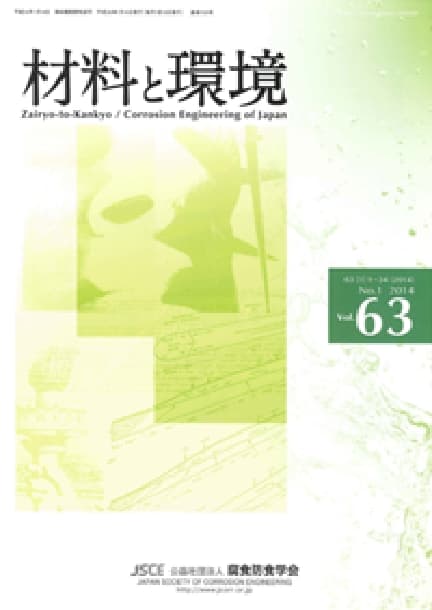- TOP
- Zairyo-to-Kankyo
- Vol. 59 (2010), No. 3
Zairyo-to-Kankyo Vol. 59 (2010), No. 3
Backnumber
-
Vol. 74 (2025)
-
Vol. 73 (2024)
-
Vol. 72 (2023)
-
Vol. 71 (2022)
-
Vol. 70 (2021)
-
Vol. 69 (2020)
-
Vol. 68 (2019)
-
Vol. 67 (2018)
-
Vol. 66 (2017)
-
Vol. 65 (2016)
-
Vol. 64 (2015)
-
Vol. 63 (2014)
-
Vol. 62 (2013)
-
Vol. 61 (2012)
-
Vol. 60 (2011)
-
Vol. 59 (2010)
-
Vol. 58 (2009)
-
Vol. 57 (2008)
-
Vol. 56 (2007)
-
Vol. 55 (2006)
-
Vol. 54 (2005)
-
Vol. 53 (2004)
-
Vol. 52 (2003)
-
Vol. 51 (2002)
-
Vol. 50 (2001)
-
Vol. 49 (2000)
-
Vol. 48 (1999)
-
Vol. 47 (1998)
-
Vol. 46 (1997)
-
Vol. 45 (1996)
-
Vol. 44 (1995)
-
Vol. 43 (1994)
-
Vol. 42 (1993)
-
Vol. 41 (1992)
-
Vol. 40 (1991)
Keyword Ranking
20 Dec. (Last 30 Days)
Zairyo-to-Kankyo Vol. 59 (2010), No. 3
Detection of Pinhole Defects in Plated Layers of Flexible Flat Cables by Anodic Polarization Method
Shigeyoshi Nakayama, Takayasu Sugihara, Akihisa Hosoe, Shinji Inazawa
pp. 70-74
DOI:
10.3323/jcorr.59.70Abstract
Anodic polarization method was applied for the investigation of pinhole defects in a gold-plated or a nickel-plated layer of FFCs (Flexible Flat Cables). Pinhole defects in a gold-plated layer were quantitatively determined using 5 M H2SO4 as the electrolyte. The ratio of pinhole defects over 0.05% could be evaluated. Although pinhole defects in a gold-plated layer tend to decrease with an increase of the plating thickness, an excessive use of gold results in a cost problem. But generally, pinhole defects in a gold-plated layer are considered to decrease adequately, if the qualities of a base nickel-plated layer are high enough. The method of measuring pinhole defects in a nickel-plated layer was also developed for the quality estimation. In the case with acidic electrolytes, the anodic dissolution of nickel started before that of copper. However, the use of an alkaline electrolyte (i.e., 7 M KOH) enabled us to detect the current peak due to the formation of a copper oxide without the interference of the anodic reaction of a nickel-plated layer. The evaluation lower limit of the ratio of nickel pinhole defects was around 0.01%.
Nondestructive Evaluation of Concrete Environment against Corrosion of Reinforcing Bar Using the Magnetic Corrosion Probe
Hitoshi Yashiro, Seung-Taek Myung, Eiichi Suzuki, Tetsuya Oyamada, Tadashi Fujiwara
pp. 75-79
DOI:
10.3323/jcorr.59.75Abstract
The goal of this paper is to evaluate the environment within concrete nondestructively related to corrosion of reinforcing bar using the newly developed magnetic corrosion probe which is introduced into concrete to raise a magnetic signal. The probe was prepared by electroplating of iron onto a copper bar, which was subsequently heat treated at 423 K for 30 min to stabilize the residual magnetization. The residual magnetization from the probe, as detected by superconducting interference device (SQUID) decreased with progress of corrosion of the probe. The electrochemical behavior of the magnetic corrosion probe was also evaluated in a saturated Ca(OH)2 solution. The as plated probe showed a large active current density and residual magnetization. The heat treatment of the probe resulted in reduction of the active current density and residual magnetization. Meanwhile the passive current density of the probe was still higher as compared with that of an iron bar even after the heat treatment. This means that the probe is more sensitive to corrosive environment than reinforcing bars. Thus, the developed probe is expected to give a magnetic warning against degradation of surroundings in advance of the corrosion of reinforcing bar.
Article Access Ranking
20 Dec. (Last 30 Days)
-
Delayed Fracture Mechanism of 1700 MPa-Class Quenched and Tempered Bolt under Atmospheric Corrosion Environment
Tetsu-to-Hagané Advance Publication
-
Perspectives on the Promising Pathways to Zero Carbon Emissions in the Steel Industry toward 2050
ISIJ International Vol.65(2025), No.2
-
Effect of B on Surface Oxidation Behavior and Phosphatability of Si-Mn-added Cold-Rolled Steel Sheets
ISIJ International Advance Publication
-
Factors Influencing the Bonding Phase Structure of Iron Ore Sinters
ISIJ International Vol.43(2003), No.9
-
Effect of microstructural heterogeneity on fatigue limit of as-quenched low-carbon low-alloy martensitic steel
ISIJ International Advance Publication
-
Prussian blue as a fully reversible hydrogenochromic material for visualizing hydrogen distribution in Fe sheet
ISIJ International Advance Publication
-
Metallurgical Aspects on Interstitial Free Sheet Steel From Industrial Viewpoints
ISIJ International Vol.34(1994), No.1
-
Influence of Antimony on the Oxidation Characteristics of 65Mn Steel
ISIJ International Advance Publication
-
From plasticity to fracture in pearlitic microstructures: Atomistic study of cementite thickness and deformation localization
ISIJ International Advance Publication
-
Growth, Removal, and Agglomeration of Various Type of Oxide Inclusions in Molten Steel
ISIJ International Advance Publication
You can use this feature after you logged into the site.
Please click the button below.










